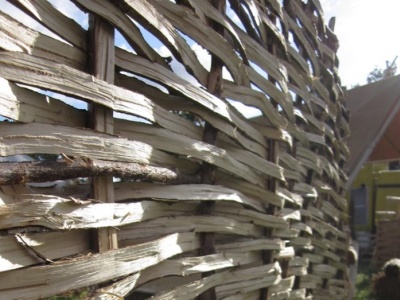
Hazel Hurdle Making
- The Green Wood Centre
- 27 Apr 2024
The future of woodlands relies on effective management, just as a garden needs constant maintenance and care to thrive. Trees must be thinned to grow well and invasive species like bramble have to be managed so that they don’t dominate other plants.
Woodlands that have a reason to be managed, perhaps for timber, firewood, access or green woodworking, are more likely to be receive love and attention long into the future, and indeed those woodlands that we have today have survived precisely because they have had an economic value to the local community:
British woodlands generate a wide range of products. Obviously there is timber, but with growing concerns about the use of finite mineral-based products and issues regarding global transport, people are looking to local woods for fuel or building materials, for hedginglaying, green woodworking and even food. If woodlands are left unmanaged they will tend to decline, and though not everyone agrees, there is evidence that managed woodlands promote biodiversity. Certainly wood within unmanaged woodlands will soon become difficult to extract and potentially unsuitable. Species of flora and fauna get to dominate and change the ecosystem. Invasive plants; such as rhododendron, and animals; like deer and grey squirrels, can take over, at the cost of native species if woodlands aren’t cared for.
Woodlands tend to be managed either by volunteers and philanthropists looking to conserve the fabric of woods, or because there is a market for woodland products. If you buy something from a woodland you are helping to fund the wood’s management, and hopefully encouraging its sustainable future. Woodlands that pay their way are more likely to be retained, rather than being left to decay and potentially be lost. By buying locally produced timber you are supporting the local economy, and reducing imports of hardwoods which are potentially illegally logged (if not from a certified source).
Coppicing is Britain’s most ancient form of woodland management, with archaeological evidence dating back thousands of years. The main principle of coppicing is to cut down a young tree to near ground level, allowing the new shoot/stems to grow from the cut stump (the ‘stool’), then after a given period of time (5 - 30 yrs), cutting the new stems that have regrown.
Coppicing ensures a continual (sustainable) supply of roundwood material for wood products without the need for clear felling and replanting. Many green wood products made from coppice material can be made entirely with wood, without plastic.
Different coppice species have different qualities and continue to be used for a wide range of both traditional and contemporary uses. Hazel can be split and weaved into hurdles for example whilst it is still green, whilst sweet chestnut is more durable outdoors and is therefore good for fenceposts. It is thought that many tens or a hundred or so different coppice products were once made. But today, a limited mix of traditional and more modern products are typically available, with a focus on products for gardens or allotments:
Sweet chestnut coppice is the most commercially lucrative type of coppice whereas hazel coppice is a more ‘accessible/approachable’ type of coppice in terms of management and range/type of product. Chestnut and hornbeam coppice tend to feature more prominently in the southeast.
In addition to wood produce, coppice woodlands are a fantastic example of sustainable woodland management in practice - delivering benefits to wildlife, providing land-based (often rural) employment, and providing human wellbeing opportunities through social forestry. It therefore still has plenty to offer modern British society now in the green recovery following the 2020 coronavirus pandemic, and will play a key role addressing the climate & biodiversity crisis in the longer term.
Although the sector is not critically endangered, the extent and quality of coppice woodlands is a mere fraction of what it once was, and many coppice workers and allied trades struggle to make a viable livelihood. Much more therefore needs to be done at a national and local level to promote and support coppice woodland and coppicing, including financial incentives to restore neglected coppice woodlands into viable management, establishing new markets and sectors for contemporary coppice products, and greater awareness of the heritage and cultural aspects of coppicing. The Small Woods Association's National Coppice Development Project was introduced to help promote coppice produce and markets. See here.
For more information on coppicing, see our article 'An Introduction to Coppicing' in our Members user area here.
Wood for Good: The website Website for timber industry's campaign to promote the use of wood in design and construction
Coppice Products: The website hosting a database of coppice producers and produce. Part of the Small Woods Association's National Coppice Development Project.